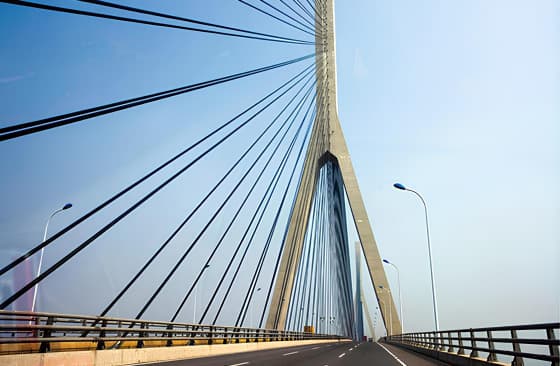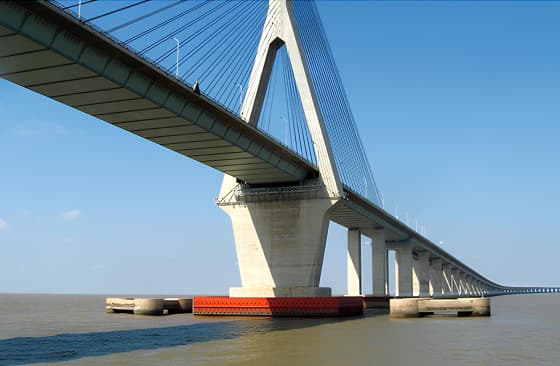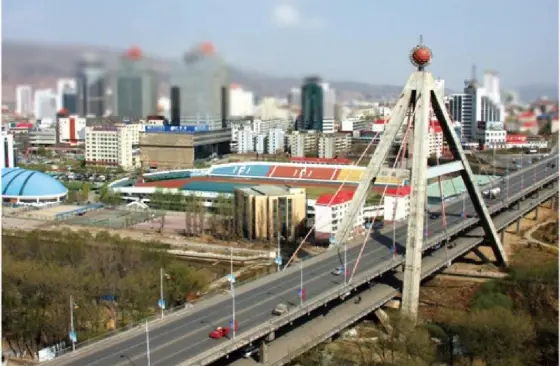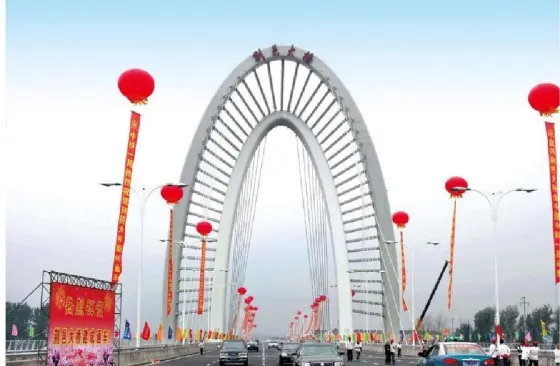Cable-stayed bridges take the "bridge tower + stay cable + main beam" as their core collaborative force-bearing system, and are one of the mainstream configurations for long-span bridges. The selection of key components and parameter coverage are as follows:
Main beam types: Centered on steel box girders and steel truss girders, they also include concrete main beams and steel-concrete composite beams (to meet different span and economic requirements);
Stay cable configuration: The mainstream adopts 1860MPa-grade parallel wire cables; in some scenarios, steel strands or composite cable bodies can be used. The cable plane types are divided into single cable plane and double cable plane;
Core parameter range: The height of bridge towers ranges from 50m to 260m (adjusted according to main span and force-bearing requirements), and the main span covers 400m to 1120m, which can meet the needs of medium-span, long-span and extra-long-span bridges (among which 1120m is the current upper limit of the main span for steel box girder cable-stayed bridges, e.g., Chaoma Railway Bridge);
Typical structural subtypes: Including double-tower double-cable-plane (mainstream configuration, e.g., Sutong Yangtze River Bridge), three-tower single/double-cable-plane (for special span requirements, e.g., Taizhou Yangtze River Bridge), high-low tower composite beam (suitable for terrain height difference scenarios), single-tower double-cable-plane (commonly used for medium and small spans), etc.;


Donghai Bridge in Shanghai
This bridge has a total length of 31 km,of which 28km is on the sea. The bridge deck has six lanes with a total width of 31.5 m. The max spal of the bridge is 420 m. It is a cable-stayed bridge with double towers and a single cable plane. The super structure is composed of box girders, composite beams, and reinforced concrete decks. It has : total of 107 bridge segments which are all bolted together.

Kunlun Road Bridge on Qinghai-Tibet Highway
This bridge is a single tower cable-stayed bridge. It has two levels of decks which have max span of 67.4 m. The main tower is composed of concrete encased steel sections. A total of 5,025 tons of steel was used.
(1)Strong span-breaking capability: The maximum main span can reach 1120m, far exceeding the span limits of beam bridges and arch bridges.
(2)High structural efficiency: Stay cables transmit the main beam load to the bridge towers at multiple points, reducing the cross-sectional size of the main beam by 30%-40% compared with beam bridges of the same span and achieving better steel consumption efficiency.
(3)Excellent environmental adaptability: Wind resistance (capable of withstanding Category 12 typhoons) and seismic resistance (seismic fortification intensity of 7 degrees) have been verified through wind tunnel tests and dynamic simulations, making it suitable for complex environments such as offshore areas and canyons.


Q1: What is the correlation between the main tower height and main span of a cable-stayed bridge? How to determine a reasonable tower height?
A1: The main tower height must satisfy a "stay cable inclination angle of 25°-45°" (an excessively small inclination angle will result in excessive cable force, while an excessively large one will lead to redundant tower height). The actual design also needs to consider navigation clearance and height restrictions of surrounding buildings, and the final reasonable tower height is determined through the balance between structural force calculations (tower column axial force and bending moment) and economic efficiency.
Q2: What is the service life of stay cables? Does subsequent replacement affect bridge operation?
A2: Stay cables adopt PE sheathing + galvanized steel wires, with a service life of 25-30 years in ordinary atmospheric environments. For marine environments, the service life can reach 20-25 years by adding an epoxy glass flake coating. The replacement adopts a "one-by-one replacement" process without interrupting operation: the replacement cycle of a single stay cable is 3-5 days, and temporary supports are equipped to fix the main beam.

International Department: Room 2507-2508, Tower C of Wanda Plaza, Tongzhou District, Beijing 101118, China.
+86-13021287080
info@boyoun.cn